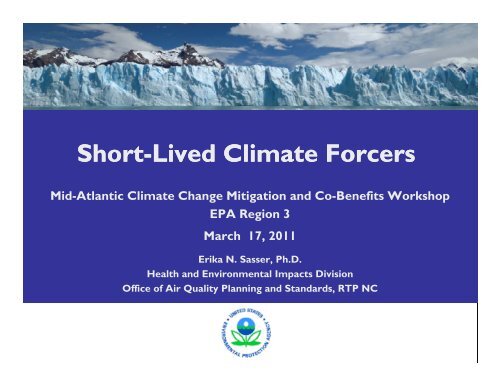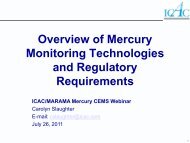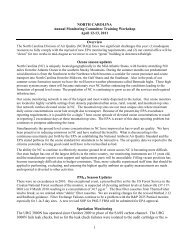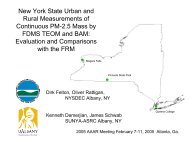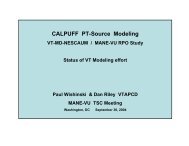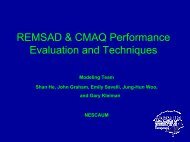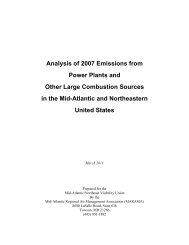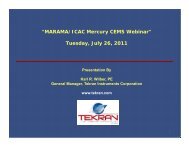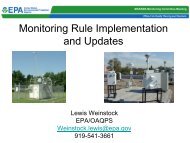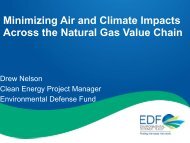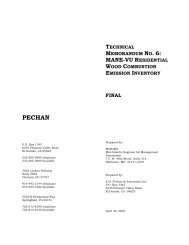Short-Lived Climate Forcers - MARAMA
Short-Lived Climate Forcers - MARAMA
Short-Lived Climate Forcers - MARAMA
- No tags were found...
Create successful ePaper yourself
Turn your PDF publications into a flip-book with our unique Google optimized e-Paper software.
<strong>Short</strong>-<strong>Lived</strong> <strong>Climate</strong> <strong>Forcers</strong>Mid-Atlantic <strong>Climate</strong> Change Mitigation and Co-Benefits WorkshopEPA Region 3March 17, 2011Erika N. Sasser, Ph.D.Health and Environmental Impacts DivisionOffice of Air Quality Planning and Standards, RTP NC
What is a “<strong>Short</strong>-<strong>Lived</strong> <strong>Climate</strong> Forcer”?• A “climate forcer” is any gas or particle that alters the Earth’s energybalance by absorbing bi or reflecting radiation:i– Greenhouse gases (e.g. CO 2 , methane, ozone) warm the climate by trappingoutgoing radiation from the Earth’s surface– Particles, such as black carbon and sulfates, can be either warming or cooling,depending on composition• Some climate forcers—like methane, ozone and black carbon– areconsidered “short-lived” because they only stay in the atmosphere for ashort time (black carbon = days/weeks, methane = a decade)– By contrast, “long-lived” climate pollutants like CO 2 and HFCs can stay in theatmosphere for hundreds of years or longer– Reductions in short-lived climate forcers have the potential to provide near-term climate benefitsU.S. Environmental Protection Agency – Office of Air and Radiation2
Comparison of Global Average Radiative Forcingof Key <strong>Short</strong>-<strong>Lived</strong> <strong>Forcers</strong> vs. CO 22Global Mean Ra adiative Forcin ng (W/m 2 )1.510.50-0.5Ramanathan and Carmichael 2008IPCC2007-1CarbonDioxideMethaneBlackCarbonOzone Nitrate OrganicCarbonSulfates(Adapted from IPCC Synthesis Report, 2007; as well as Ramanathan and Carmichael, 2008)U.S. Environmental Protection Agency – Office of Air and RadiationCloudIndirectEffect(all aerosols)3
<strong>Short</strong>-<strong>Lived</strong> <strong>Climate</strong> <strong>Forcers</strong> (SLCF):Reasons for Taking Action• Keeping temperature change below 2ºC may depend on reducing SLCF– GHGs are largest contributors to current and future climate change, so GHGreductions are essential to mitigating climate change in the long run. However, thebenefits will take time to manifest due to persistence of GHGs in atmosphere.• Reducing SLCF emissions now may provide numerous benefits:– Avoid rapid near-term climate change (temperature and other impacts)– Slow melting of the arctic and alpine glaciers– Help reach and maintain the Ozone NAAQS– Public health co-benefits (esp. black carbon)• Main pollutants of concern:– Black carbon (BC)– Methane, which is both a GHG and a precursor to tropospheric ozoneImage e: Glaciers OnlineJurg AleanU.S. Environmental Protection Agency – Office of Air and Radiation4
Even aggressive CO 2 reductions, may not keep climate change fromapproaching 2ºC by mid-century2011 UNEP Assessment Report (draft)Figure 3. Observed temperatures (to 2009) and projections under various scenarios. Immediateimplementation of the identified BC and methane measures, together with measures to reduce CO 2 , emissions wouldgreatly improve the chances of keeping Earth’s temperature increase to less than 2 o C relative to pre-industrial levels.
Need Integrated Strategies to Address<strong>Climate</strong> and Air Quality• Air pollution controls are already changing climate– Historically, emissions of SOx and NOx which formreflective aerosols have helped to cool the atmosphere,countering the effects of GHG– Recent SOx/NOx emissions reductions are now leading toan “unmasking” of the true effects of CO 2– Need to consider overall impacts of air pollution controlsto design “climate friendly” strategiesU.S. Environmental Protection Agency – Office of Air and Radiation6
Recent SLCF Activities• Convention on Long-Range Transboundary Air Pollution (C-LRTAP): Considering adding black carbon to the Gothenburg Protocoland promoting technical work on methane as an ozone precursor• United Nations Environment Program (UNEP) Black Carbonand Ozone Assessment– final June 2011• Black Carbon Report to Congress. Required by Oct. 2009 HouseInterior Appropriations bill. Peer review draft March 18, 2011• Arctic Council Task Force on <strong>Short</strong> <strong>Lived</strong> <strong>Climate</strong> <strong>Forcers</strong>–covers emissions/impacts/mitigation options for BC in Arctic. Final May2011• “Bounding BC” study from International Global AtmosphericChemistry (IGAC)/Stratospheric Processes and their Role in <strong>Climate</strong>(SPARC) projects– focus on reducing scientific uncertainties about BC.Summer 2011?U.S. Environmental Protection Agency – Office of Air and Radiation7
METHANE:CLIMATE POLLUTANT ANDCONTRIBUTOR TO BACKGROUND OZONEU.S. Environmental Protection Agency – Office of Air and Radiation8
Attaining More Stringent Ozone NAAQS• Ozone NAAQS Reconsideration Proposal (January 6, 2010).EPA proposed:– To revise the level of the primary 8-hour ozone standard to a levelwithin the range of 0.060-0.070 ppm– To establish a separate cumulative secondary standard within a range of7-15 ppm-hrs• Final Rule pending (expected July 2011)U.S. Environmental Protection Agency – Office of Air and Radiation9
HTAP 2010 FindingsIncreasing Ozone TrendsAverage springtime O 3 levels at remote orhigh-altitude sites across the NorthernHemisphere have shown very consistenttrends.• These trends suggest that t baseline O 3 innorthern mid-latitudes has increased by atleast a factor of two since 1950.• At some sites on the western edge ofcontinental regions, observed levelsapproach or exceed the levels of someambient standards or objectives.
CH 4 is an O 3 Precursor• Addressing background O 3 requires reducing emissions of all precursorsglobally–not just NOx!• Global methane emissions have been increasing, and expected futureincreases are likely to offset the benefits of reducing emissions of otherO 3 precursors• Methane emission reductions are available from a variety of sectors, someat very low or no net cost• It doesn’t matter where the methane reductions take place, but the O 3decreases are spread out globally and accrue over time (~ 60% of benefitsare achieved in first 10 years, > 90% of benefits are achieved in 20 years)• Decreasing methane offers a clear “win-win” for climate and air qualityU.S. Environmental Protection Agency – Office of Air and Radiation11
Domestic v. GlobalAnthropogenic Methane SourcesCategory U.S. (2007) Global (2005)Enteric Fermentation 24% 30%Landfills 23% 12%Oil & Gas 23% 18%Coal 10% 6%Manure Management 8% 4%Waste Water 4% 9%Fuel Combustion 2% 1%Rice 1% 10%Other 5% 10%U.S. Environmental Protection Agency – Office of Air and Radiation12
U.S. Methane Activities• Voluntary Programs– Natural Gas STAR– Coalbed Methane Outreach Program– Landfill Methane Outreach Program– AgSTAR• Regulatory Programs– Mobile Source Emissions Standards– GHG Emissions Reporting– Stationary Source Permitting Issues– Ozone NAAQS Implementation IssuesU.S. Environmental Protection Agency – Office of Air and Radiation13
Global Methane Activities• UNFCCC• Included in “Kyoto Basket” of GHGs• Not in the EU Trading System• Global Methane Initiative• Expanding scope beyond marketable methane recovery• Encouraging development of National Action Plans• UNEP: Integrated Assessment of Black Carbon and Tropospheric Ozone(http://www.unep.org/dewa/Portals/67/pdf/Black_Carbon.pdf)• U.S. and European countries engaged in discussions aboutpossible technical work on methane under LRTAPU.S. Environmental Protection Agency – Office of Air and Radiation14
BLACK CARBON:IMPACTS AND MITIGATIONU.S. Environmental Protection Agency – Office of Air and Radiation15
BC Report to Congress:October 2009 Interior Appropriations p Bill Requirement• “Not later than 18 months after the date of enactment of this Act, theAdministrator, i in consultation with other Federal agencies, shall carry outand submit to Congress the results of a study on domestic andinternational black carbon emissions that shall include– an inventory of the major sources of black carbon,– an assessment of the impacts of black carbon on global and regional climate,– an assessment of potential metrics and approaches for quantifying the climaticeffects of black carbon emissions (including its radiative forcing and warmingeffects) and comparing those effects to the effects of carbon dioxide and othergreenhouse gases,– an identification of the most cost-effective approaches to reduce black carbonemissions, and– an analysis of the climatic effects and other environmental and public healthbenefits of those approaches. ”U.S. Environmental Protection Agency – Office of Air and Radiation16
<strong>Climate</strong> Impacts of BC• BC is most strongly light-absorbingcomponent of direct PM 2.5– Product of incomplete combustion• Affects climate by:– Absorbing incoming and reflected sunlight– Darkening clouds, snow and ice, therebyreducing reflection of light back to space(albedo)– Altering precipitation and cloud patterns--reducing rainfall and increasing surfacedimmingi• Remains in atmosphere only days to weeks• Principally a regional pollutant (unlike CO 2 )U.S. Environmental Protection Agency – Office of Air and Radiation17
BC Regional Impacts: Arctic• Arctic temperatures increasingfaster than global average (IPCC, 2007)• BC may be significant contributorto Arctic warming and ice meltGlobal vs. Arctic Warming 1822 to 2003Source: Reuters(Reiersen and Wilson, AMAP, 2009; adapted from Quinn 2008)U.S. Environmental Protection Agency – Office of Air and Radiation18
BC Impacts: GlaciersIn the Himalayan region, solar heating fromBLACK CARBON at high elevations may bejust as important as carbon dioxide in themelting of snowpacks and glaciers(Ramanathan & Carmichael, 2008)Western U.S.Himalayas: Source of 14 MajorRivers in Asia Under Threatoto: USGSPho
BC Impacts: Precipitation• Pollution plumes knownas Atmospheric BrownClouds (ABCs) may alsoaffect rainfall patterns– ABCs contain significantamounts of BC, as well asorganic carbon, sulfates,nitrates, and dust• Can persist up to 7months per yearAtmospheric Brown CloudNASA Goddard Space Flight Center/Jeff SchmaltzU.S. Environmental Protection Agency – Office of Air and Radiation20
Global Sources of Black Carbon:(Lamarque et al., 2010)
U.S. Domestic Sources of BCBC Emissions (0.64 Million Tons)1.1%35.3%52.3%3.6%1.0%6.8%Open Biom as s Bur ningEnergy/PowerMobile SourcesOtherRe side ntialIndustrialUS≈6% of Global
Mitigation of Black Carbon• Location of emissions matters for climate: main focus is on emissionsaffecting sensitive regions, such as the Arctic (i.e. emissions north of 40 olatitude) and other ice/snow covered regions (emissions reaching Himalayas)• Black carbon generally emitted (andcontrolled) as part of a pollution mixture– <strong>Climate</strong> impacts of mitigation depend onco-pollutant changes• Controls on some sources/sectors moreclearly climate beneficial than others (e.g.,mobile diesel vs. open biomass burning)– Ratio of BC to other (cooling) constituentslike organic carbon (OC) varies• Virtually all mitigation options will bebeneficial to public healthU.S. Environmental Protection Agency – Office of Air and Radiation23
BC Report to Congress: Schedule• External peer-review draft of the report scheduled to bereleased March 18, 2011– Peer review will be conducted by a panel of experts from EPA’sCouncil on Clean Air Compliance Analysis in Washington, D.C. onApril 18-19, 2011– Draft report will be available at EPA’s Science Advisory BoardWebsite, athttp://yosemite.epa.gov/sab/sabpeople.nsf/WebCommittees/COUNCIL• Final report scheduled to be released later in 2011U.S. Environmental Protection Agency – Office of Air and Radiation24
Summary of Key Messages fromthis Presentation• Near-term climate change and long-term climate change arerelated: both problems require attention now, and addressingnear-term change means addressing SLCF• SLCF are air pollutants: their climate impacts should beconsidered in air quality management along with health andecosystem impacts.• Black carbon is a clear winner for both climate and public health,as long as careful attention is paid to co-pollutants issue• Methane is an O 3 precursor (like NOx, VOC, and CO)– Controlling methane could provide significant benefits for health,ecosystems and climateU.S. Environmental Protection Agency – Office of Air and Radiation25


